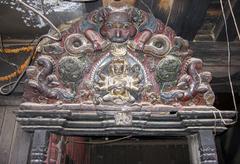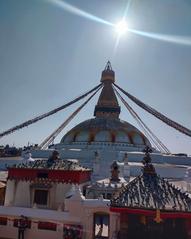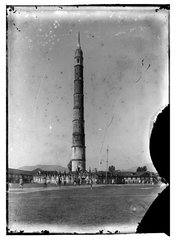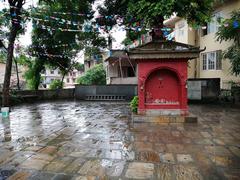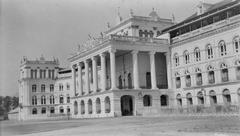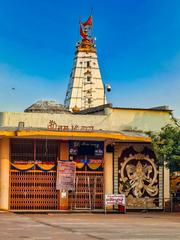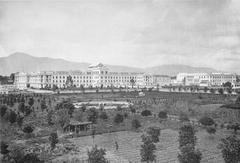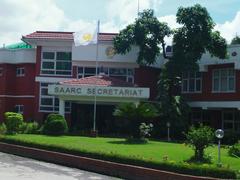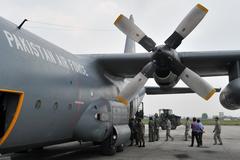Swayambhunath Visiting Hours, Tickets, and Travel Guide: Kathmandu Historical Sites
Date: 14/06/2025
Introduction to Swayambhunath and Its Significance
Swayambhunath, also known as the Monkey Temple, is one of Kathmandu’s oldest and most revered religious monuments. Located atop a hill approximately 3 kilometers west of Kathmandu’s city center, this ancient Buddhist stupa is a profound symbol of Nepal’s spiritual and cultural heritage. Its origins trace back over two millennia and are rooted in local legends describing a primordial lake and a self-existent flame—“Swayambhu”—symbolizing enlightenment (Nepal Tourism Board; Explore Buddham). Swayambhunath epitomizes Nepal’s religious harmony, where Buddhist and Hindu traditions merge seamlessly; both monks and priests perform rituals side by side.
The stupa’s grand white dome, crowned by a gilded spire with thirteen tiers, represents the journey towards enlightenment. The all-seeing eyes of the Buddha gaze in all directions, embodying wisdom and compassion. Surrounding the stupa are prayer wheels, shrines, and vibrant festivals like Buddha Jayanti, creating a living spiritual ambiance (Buddhist Monasteries; Nepali Sansar).
Swayambhunath is open daily from early morning to evening, with a nominal entry fee for foreign tourists, supporting preservation efforts (tourinnepal.com). The site is accessible by a staircase of 365 steps or a motorable road for those with mobility challenges (teentravelguru.com). As a UNESCO World Heritage Site, Swayambhunath stands as a beacon of peace, religious tolerance, and cultural resilience in the Kathmandu Valley (MyRepublica; IMNepal).
Table of Contents
- Origins and Historical Development
- Architectural Features and Symbolism
- Religious Significance in Buddhism
- Hindu-Buddhist Syncretism and Local Legends
- Visiting Hours and Ticket Information
- How to Get There
- Nearby Attractions
- Pilgrimage, Rituals, and Festivals
- Swayambhunath as a Symbol of Peace and Harmony
- Visuals and Interactive Media
- Frequently Asked Questions (FAQ)
- Preservation Efforts and Community Engagement
- Summary and Visiting Tips
- References and Further Reading
Origins and Historical Development
Swayambhunath’s origins are deeply rooted in both legend and archaeological evidence, stretching back over two millennia. Buddhist texts describe the Kathmandu Valley as a primordial lake from which a lotus flower and a self-existent flame of enlightenment emerged. This lotus is said to have become the hill where Swayambhunath stands. The current stupa was constructed around 460 A.D. by King Manadeva, but the site’s spiritual significance predates this structure. Over centuries, Swayambhunath became a focal point for Buddhist learning and pilgrimage (Nepal Tourism Board; Explore Buddham).
Architectural Features and Symbolism
Swayambhunath’s architecture is a remarkable blend of Buddhist and Hindu elements, reflecting Nepal’s syncretic culture. The central stupa’s whitewashed dome symbolizes the world, topped by a gilded spire with thirteen tiers for the stages of enlightenment. The all-seeing Buddha eyes on each side of the harmika represent wisdom and compassion (Explore Buddham).
Surrounding the stupa are smaller chaityas (shrines), statues, and prayer wheels. On the eastern side stands a massive gold-plated Vajra (thunderbolt), a key symbol in both Buddhist and Hindu tradition. The Dewa Dharma Monastery, with its bronze Buddha and intricate Tibetan paintings, and the Harati Temple, dedicated to the goddess of children, are significant highlights (Nepal Tourism Board).
Religious Significance in Buddhism
As one of Nepal’s holiest Buddhist stupas, Swayambhunath is a central pilgrimage site and spiritual center. The stupa’s thirteen tiers represent the steps to nirvana, and the dome signifies the unity of all sentient beings. Major Buddhist festivals, especially Buddha Jayanti, see thousands of devotees gather for prayers and celebrations (Nepal Tourism Board; Explore Buddham).
Hindu-Buddhist Syncretism and Local Legends
Despite its Buddhist origins, Swayambhunath holds deep significance for Hindus as well. The site features several Hindu shrines and is a place where Buddhist and Hindu rituals occur harmoniously. Legends such as that of Manjushri draining the valley’s lake to reveal the Swayambhu flame and the transformative story of Harati Devi further enrich its cultural tapestry (Nepal Tourism Board).
Visiting Hours and Ticket Information
- Opening Hours: Daily, 6:00 AM to 6:00 PM
- Entry Fees:
- Foreign nationals: NPR 200
- SAARC nationals: NPR 50
- Nepali citizens and children: Free
Tickets are available at the main entrances (tourinnepal.com; peregrinetreks.com). Carry local currency as card payments may not be accepted.
How to Get There
Swayambhunath is located about 3 km west of Kathmandu’s city center. Taxis are convenient and cost around USD 4–5 each way. Local buses are available but may be less direct. The eastern entrance features the iconic 365-step staircase; the western entrance is accessible by vehicle, suitable for those with mobility issues (teentravelguru.com; peregrinetreks.com).
Nearby Attractions
Pair your visit with other UNESCO World Heritage Sites in Kathmandu, such as Kathmandu Durbar Square, Pashupatinath Temple, and Boudhanath Stupa. Tibetan settlements and monasteries near Boudhanath further enrich the experience.
Pilgrimage, Rituals, and Festivals
Swayambhunath is a vibrant center of daily rituals and annual festivals. Pilgrims circumambulate the stupa, spinning prayer wheels, and making offerings. The site is especially lively during Buddha Jayanti, Losar (Tibetan New Year), and Gunla Parva, when processions, chanting, and decorations transform the site (Nepal Tourism Board; Explore Buddham).
Swayambhunath as a Symbol of Peace and Harmony
Swayambhunath is more than a monument; it is a living symbol of peace and religious tolerance. Its hilltop offers panoramic views over Kathmandu Valley, and the presence of sacred monkeys adds a playful dimension to its spiritual atmosphere (Nepal Tourism Board; Explore Buddham).
Visuals and Interactive Media
- Explore Buddham offers detailed photo galleries and virtual tours.
- Interactive Map of Swayambhunath Complex
Frequently Asked Questions (FAQ)
What are Swayambhunath’s opening hours?
6:00 AM to 6:00 PM daily.
Is there an entrance fee?
Yes. Foreign nationals: NPR 200; SAARC nationals: NPR 50; Nepali citizens: Free.
Is Swayambhunath accessible for people with mobility challenges?
Yes, via the western entrance by vehicle.
What is the best season to visit?
September–November and March–April for pleasant weather and clear views.
Are guided tours available?
Yes, local guides provide historical and spiritual insights.
Preservation Efforts and Community Engagement
Restoration and Conservation
As a UNESCO World Heritage Site since 1979, Swayambhunath has seen significant restoration—especially after the 2015 earthquake. Projects focus on reinforcing structures, repairing the pinnacle, and conserving artistic details, using traditional methods (MyRepublica; NTB).
Environmental and Artistic Preservation
Environmental management includes waste control and education programs to ensure cleanliness and respect for the sacred grounds (IMNepal). Artistic conservation preserves statues, paintings, and ritual objects with support from local and international organizations.
Community Stewardship
The Swayambhu Management Committee and local volunteers oversee daily care, restoration, and cultural events. Interfaith dialogue and educational workshops foster respect and understanding among visitors and locals (IMNepal).
Summary and Final Tips for Visiting Swayambhunath
Swayambhunath is an unrivaled symbol of Nepal’s spiritual heritage, blending ancient history, stunning architecture, and vibrant living traditions. Its accessible location, clear visiting hours, and thoughtful ticketing support both conservation and community engagement. Respectful behavior, suitable attire, and adherence to cultural norms will enhance your experience. For deeper understanding, consider guided tours or visits during major festivals. Swayambhunath is an essential stop for anyone exploring Kathmandu’s historical sites (Nepal Tourism Board; Explore Buddham; MyRepublica; teentravelguru.com; tourinnepal.com; travelsetu.com).
For the latest updates, consult official websites or download travel apps like Audiala.
References and Further Reading
- Nepal Tourism Board – Swayambhunath
- Buddhist Monasteries – Swayambhunath Stupa
- Teen Travel Guru – Swayambhunath Travel Guide
- MyRepublica – Renovation of Swayambhunath
- IMNepal – Cultural Significance of Swayambhunath
- TourInNepal – Kathmandu UNESCO Heritage Sites Entrance Fees
- TravelRight – Visiting the Monkey Temple
- TravelSetu – Best Time to Visit Swayambhunath Temple
- ImNepal – Story Behind Iconic Swayambhunath Stupa
- Nepali Sansar – Swayambhunath Kathmandu’s Best Loved Temple
